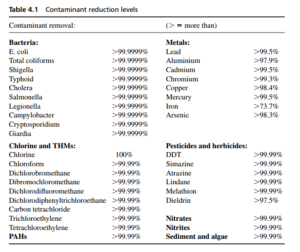0
-
An empty cart
You have no item in your shopping cart
envato-wordpress-toolkit domain was triggered too early. This is usually an indicator for some code in the plugin or theme running too early. Translations should be loaded at the init action or later. Please see Debugging in WordPress for more information. (This message was added in version 6.7.0.) in /var/www/wp-includes/functions.php on line 6121g5plus-darna domain was triggered too early. This is usually an indicator for some code in the plugin or theme running too early. Translations should be loaded at the init action or later. Please see Debugging in WordPress for more information. (This message was added in version 6.7.0.) in /var/www/wp-includes/functions.php on line 6121Tests confirm the presence of these toxic substances in drinking water, but few mains cold water lines into residential properties incorporate an effective filtration system. Ideally, drinking water should be organoleptically neutral, clear and mineralized sufficiently to give it the ‘ fresh ’ taste. It should be free from any organic matter that reacts with chlorine, and very low in biodegradable compounds, so as to impart enhanced biological stability. It should also be devoid of other undesirable matter even in trace quantities.
These requirements can be achieved in a good mains-supply drinking water filter system, and Table 4.1 shows the contaminant removal of such a system, which would include a combination of mechanical filtrations of several types plus adsorptive contaminant removal.

In the case of domestic premises, it is up to the householder (or the management of an apartment block, or hotel or hospital or other institution) to decide how much additional treatment to give to the mains water as received. If the water arrives turbid, then some kind of mechanical filtration would be advantageous, perhaps a sand bed or a replaceable element microfilter. If the water is coloured or possessed of an unpleasant taste and/or smell, than an activated carbon filter would be advisable. If there is concern over bacterial removal, then a membrane system would be needed, capable at least of microfiltration, and possibly ultrafiltration – but this is now starting to be expensive.
On the smallest scale, point-of-use treatment can provide considerable comfort. This may take the form of the kitchen counter top water jug containing a filter cartridge such as that supplied, very successfully, by Brita – which then treats only that water whose drinking and food washing characteristics are of concern. A permanent filter housing using a similar cartridge (turbidity, taste and colour removal plus bactericidal action) can be plumbed under the worktop to provide a similar level of protection.
For anything larger than the single tap, a packaged plant can be supplied, with filter and activated carbon cartridges, probably in duplex format, enabling easy removal for cleaning or replacement.
Other important features for the local filter are that the filter unit should be easily sealed, the media should be non migrating, and the whole should be heat resistant if it is to be used with hot water. It should also be easy to mount as an in-line
fitting and easy to disassemble to change the filter cartridge. Disposable cartridge filters are preferable to cleanable filters, as it is not generally possible to remove all bacteria by cleaning; also filter media may be damaged and lose their efficiency
by heavy cleaning. Accepting activated charcoal, usually combined with a silver sanitizing agent, as the main element, the additional elements used for ultra-fine mechanical filtering will finally govern the overall performance.
It is also desirable to obtain an optimum balance between what is removed and what is passed by the complete filter: some soluble mineral salt content in the final product may be desirable, rather than removing as much dissolved mineral matter
as possible (which leaves a ‘ flat ’ taste).
Filter housings made from plastic should be protected against freezing. Failure to do so may result in cracking of the filter and water loss. The capacity of the filter has to be tailored to specific needs, generally rated in terms of the quantity of water that the filter can treat before the cartridge needs replacement. This can only be an approximate rating and is very much dependent on the condition of the water being treated, the water pressure (in a pressurized system), and any pressure cycling. If the input water being handled contains a relatively high proportion of suspended matter, the life of the
clarifying filter cartridge can be considerably extended by the addition of a relatively coarse prefilter in the system, at a position where it is readily accessible for cleaning.